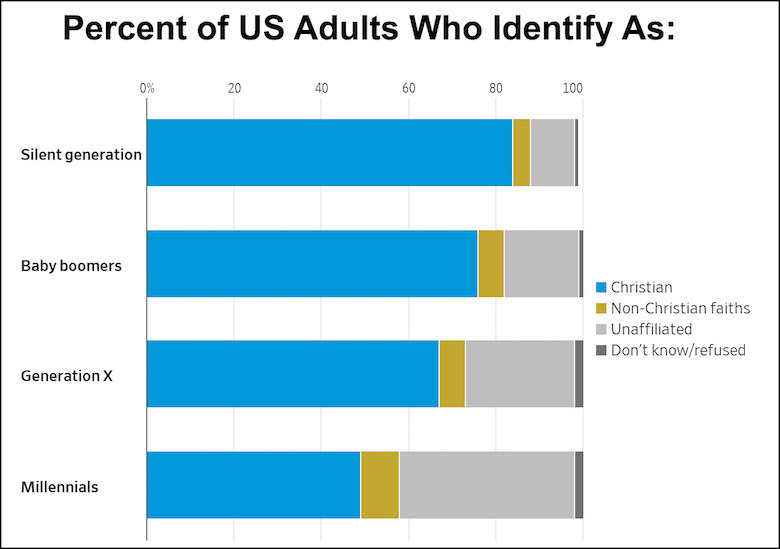Kevin Drum reproduces a chart from the Wall Street Journal that shows the results of a survey in which the percentage of people in the US who identify as Christians decreases as you go to younger age cohorts, while the number who are unaffiliated increases.
He concludes that Christianity is dying out in 21st century America as it finally catches up with Europe that saw a major drop with identification with Christianity in the last century. But such claims can be challenged by the assertion that as the young people of today get older, they will become more religious, so that there will be no long term changes.
So what we need is to compare this chart with a similar chart made decades ago to see if there is an actual drop across all age groups. Maybe the Wall Street Journal article has this information but it is behind a paywall and I cannot access it.


I followed the link to Wall Street Journal and the graph gives Source: Pew Research Center telephone surveys of 12,738 people, Jan–July 2019.
Since we have had longitudinal surveys on USA religion demographics for many decades now, and since those longitudinal surveys show long-term trends towards increasing atheism and decreasing affiliation, I’d be surprised if this isn’t foreshadowing longer-term demographic changes. Sure, some young people will get into religion as they age, and some older folk will drop out. Will those numbers equal out? Maybe not, but with the longitudinal studies we can see that whatever trend towards religious adoption or return might exist among individuals as they age isn’t enough to keep up with the decreasing religiosity of up and coming generations.
One other thing to keep in mind is that immigrants to the USA from many countries are more likely to be religious than the country’s current young adults. So that makes teasing things apart even more difficult: if there’s a change within a generation over 10 or 20 or 30 years, does that come more from adding religious outsiders to our population or more from people already here changing their minds?
In short: I’m confident that this foreshadows long term change, though I doubt that in 20 years then-50 year olds will have the exact same proportion of the religiously affiliated as is true of 30 year olds today.
A FiveThirtyEight article does not believe they (we) will become more religious, arguing that, with previous generations, the nonreligious often married religious partners being such a minority and those spouses, along with children, brought them into, or back into, religion. But now that there are so many nonreligious people, they (we) can more easily find similarly nonreligious spouses and will therefore be less likely to become religious.
It would be funny (in the not-funny way) if Republican xenophobia kept out the religious people who would make up for those leaving religion.
I would bet that the children of immigrants would also drift away from religion just like the children of those already here are doing.
OT: Merry Kitzmas to one and all!
Something else that is new is that the religious right has been so incredibly successful at co-branding religious and political identity. A big part of the drop in younger religionists relates to their being repulsed by the hatred and hypocrisy that they’re seeing the evangelical right Trumpists spitting out on a daily basis, and that seems pretty new.
The religious left had a few of its own superstars back in the sixties like Rev. Sloan Coffin, but nowadays the would-be leftist preachers like Bell or Spong can’t seem to find much of a platform.